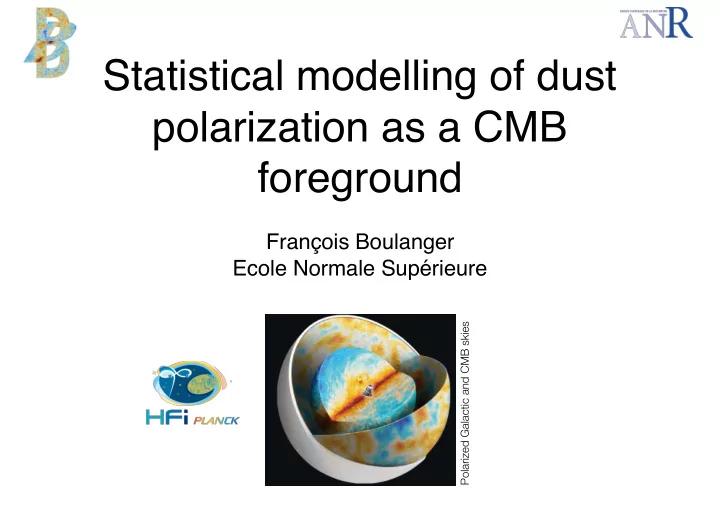

Statistical modelling of dust polarization as a CMB foreground François Boulanger Ecole Normale Supérieure Polarized Galactic and CMB skies
Take home message ‣ The successes of ever more powerful experiments have transformed observational cosmology into a high precision science. ‣ Foremost questions about our Universe do no anymore depend only on getting new data with higher sensitivity, because the cosmological signals to be discovered are small compared to the foreground emission from our Galaxy . Signature of primordial gravitational waves in the polarization of the - CMB (primordial B-modes) - CMB spectral distortions (departure from black body spectrum) - 21cm line emission of neutral hydrogen from the epoch of reionization of the Universe ‣ Today, on these topics, observational cosmology is tied to the challenge of characterizing statistically the complexity arising from non-linear interstellar physics (cosmic dust & magnetism) . François Boulanger Cosmic Dust and Magnetism Daejeon, Nov. 2, 2018
Observational cosmology credit: Josquin Errad Much is still to be learned from CMB and mainly from polarization François Boulanger Cosmic Dust and Magnetism Daejeon, Nov. 2, 2018
Planck CMB polarization map 4 François Boulanger Cosmic Dust and Magnetism Daejeon, Nov. 2, 2018
CMB Power spectra • E-mode (gradient-like) polarization validates the acoustic interpretation of temperature peaks and Density fluctuations enhances the precision of cosmological parameters. • B-mode (curl-like) polarization from gravitational lensing is also detected • No detection (yet) of the weaker B-mode signal expected from primordial Lensing gravitational waves Credit E. Calabrese François Boulanger Cosmic Dust and Magnetism Daejeon, Nov. 2, 2018
BICEP B-modes ‣ The BICEP collaboration published the deepest polarization observation ever achieved at micro-wave frequencies ‣ Initial claim: discovery of primordial B-modes Primordial B- g modes? n i s n e ‣ The Planck data analysis, followed by L a joint analysis of the Planck and BICEP data, have shown that their signal is dominated by dust polarization . BICEP Collaboration 2014 François Boulanger Cosmic Dust and Magnetism Daejeon, Nov. 2, 2018
The foreground screen from the magnetized ISM BICEP/Keck field on Planck image ‣ The power spectra of dust polarization was characterized over the whole sky using Planck data ‣ There is no sky area where the Galactic signal may be neglected ‣ Any claim for a detection will face a critical assessment against alternative interpretations involving foregrounds 60° François Boulanger Cosmic Dust and Magnetism Daejeon, Nov. 2, 2018
Polarized foregrounds power 10 4 CMB B-mode reionization bump Synchrotron BB power in ` ∼ 7.5 [ µ K 2 ] 10 2 10 2 primordial B modes Dust 10 0 lensing B modes 10 − 2 r = 0.1 10 0 r = 0.01 D dust at 150 GHz ` 10 − 4 [ µ K 2 ] r = 0.001 lensed- Λ CDM D dust at 95 GHz 10 − 6 ` D BB 10 4 0 50 100 150 200 250 300 350 10 − 2 CMB B-mode recombination bump ` Synchrotron Frequency [GHz] r = 0.1 D sync ` BB power in ` ∼ 69.5 [ µ K 2 ] at 95 GHz 10 2 r = 0.01 Dust 10 0 10 − 4 r = 0.001 10 − 2 r = 0.1 lensed- Λ CDM r = 0.01 2 10 100 500 10 − 4 r = 0.001 Multipole, ` 10 − 6 0 50 100 150 200 250 300 350 Planck collaboration XI (2018) Frequency [GHz] ➡ Planck data quantify the challenge of the component-separation procedure required for detecting the reionization and recombination peaks of primordial CMB B -modes François Boulanger Cosmic Dust and Magnetism Daejeon, Nov. 2, 2018
Moving forward with foregrounds Extending to foregrounds the statistical approach of CMB simulations Data analysis of polarization data Astrophysics of dust and synchrotron polarization: Cosmic dust & Magnetism Statistical modelling of dust polarization François Boulanger Cosmic Dust and Magnetism Daejeon, Nov. 2, 2018
Modelling motivations • Statistical modeling of foregrounds is required to confidently identify primordial CMB B-modes (or set upper limits) ‣ Propagate instrumental effects in end-to-end simulations of data pipeline ‣ Optimize component separation for CMB polarization and assess statistically uncertainties ‣ Astrophysical interpretation of data François Boulanger Cosmic Dust and Magnetism Daejeon, Nov. 2, 2018
Modelling approach • Stokes I from 353 GHz dust-only sky map (CMB and cosmic infrared background subtracted) • Magnetic field model required to compute noise-free Stokes Q and U maps • Ordered magnetic field + statistical model of turbulent component • Dust spectral energy distribution for polarization François Boulanger Cosmic Dust and Magnetism Daejeon, Nov. 2, 2018
Magnetic fields model Solar Neighborhood Windell Oskay
Solar Neighborhood magnetic field Polarization angle ψ Local Bubble Alves+ 2018 ‣ Imprint from an ordered magnetic field is clearly apparent on the map of polarization angles ‣ We may be seeing a local deformation of the Galactic magnetic field associated with the Local Bubble (Alves et al. 2018) ‣ Dust, unlike synchrotron, polarization is sensitive to this because the extension of the Bubble towards the pole is comparable to the dust scale-height François Boulanger Cosmic Dust and Magnetism Daejeon, Nov. 2, 2018
Depolarization from Turbulence Model with no turbulence polarization fraction 25% 0 Variable degree of depolarization from the superposition of a small number of ISM clouds, and magnetic coherence lengths along the line of sight, with distinct polarization François Boulanger Cosmic Dust and Magnetism Daejeon, Nov. 2, 2018
Recommend
More recommend